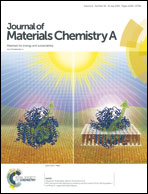Cobalt phosphosulfide in the tetragonal phase: a highly active and durable catalyst for the hydrogen evolution reaction†
Abstract
Herein, we report the first successful fabrication of sea urchin-like ternary cobalt phosphosulfide (CoPS) nanoneedles in the tetragonal phase on carbon paper (CoPS/CP). The results show that the CoPS/CP exhibits comparable performance to Pt towards the electrochemical HER with the same catalyst loading. Specifically, in 0.5 M H2SO4, this sea urchin-like CoPS hybrid exhibits a negligible onset overpotential of ∼4 mV and a small Tafel slope of 42.6 mV dec−1, and the turnover frequency (TOF) reaches as high as 0.18 s−1 at an overpotential of 100 mV. Additionally, this CoPS/CP electrode shows excellent catalytic durability (100 hours) under both acidic and basic conditions. Density functional theory (DFT) calculations indicated that CoPS exhibits the most suitable hydrogen adsorption free energy (−0.12 eV). This work will open an exciting new direction for the rational design and scalable fabrication of easily-prepared, cost-effective, highly active and robust non-noble metal catalysts for energy storage and conversion, and other applications.



 Please wait while we load your content...
Please wait while we load your content...